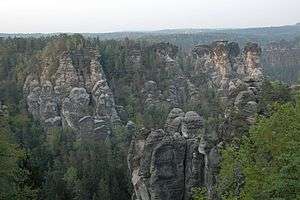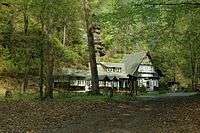Saxon Switzerland
Saxon Switzerland (German: Sächsische Schweiz) is an area in Saxony, Germany, so named after its picturesque upland scenery.
- Not to be confused with Switzerland, a country hundreds of miles to the southwest.

About 30 km (18 mi) upward the Elbe River from Dresden this is a mountain area made of sandstone. Bizarre stone formations and spectacular views are only a few characteristics of this region that is ideal for hiking, but also for a relaxed day out. For those who like nature, it is surely the most beautiful landscape in Saxony. It can get crowded along the river at summer weekends, if you don't like this, try the colder days. In late autumn or even winter you will nearly be alone outside the villages. There are also many rock castles and caves within the region, most worth a visit. Further up stream along the Elbe/Labe one enters the Czech Republic. However, the rock formations and the natural splendor continue and this region is known historically as the Bohemian Switzerland or "Böhmische Schweiz" in German.
Cities
- 🌍 Pirna - a bigger historically industrial town, called the gate to Saxon Switzerland
- 🌍 Bad Gottleuba-Berggießhübel a well known cure spa close to Saxon Switzerland
- 🌍 Bad Schandau - on the river within Saxon Switzerland
- 🌍 Heidenau - former chemical industrial town between Dresden and Pirna
- 🌍 Königstein
- 🌍 Rathen - Bastei rock formation and Open-air-arena Felsenbühne
- 🌍 Sebnitz - bigger Saxon province town in Saxon Switzerland
Other destinations
Understand

The mountain range was formed after the sea retreated and left (Cretaceous era, roughly contemporary with T-Rex) sandstone as the remains. It was once a wild area, known for robbers and hard to conquer strongholds. Many of those still remain and can be visited. The most impressive is certainly the fortress of Königstein that was used for centuries as jail for high-ranking prisoners.
Talk
Like in most other parts of Germany, English is generally well understood by people, in this area especially by people under 50. Some know Russian and some, since more recently, also Czech. As this region is close to the border some signs will be in Czech and/or Polish.
Get in
Saxon Switzerland is best accessible from Dresden by suburban train (S-Bahn).
By train
Probably the most comfortable way to get in, even faster than car due to a direct line along the river Elbe. Eurocity trains from Prague (1:45 hours) and Berlin (2½ hours) call in Bad Schandau every two hours. Otherwise you may take an intercity or high-speed train to Dresden and connect to the half-hourly running suburban train line S1, direction Bad Schandau, that stops in several towns of Saxon Switzerland (incl. Pirna, Rathen, Königstein), taking between 20 and 45 minutes from Dresden main station. Every other S1 (i.e. hourly) continues until Schöna on the Czech border (55 minutes from Dresden).
By car
It may be a little tricky to find the roads out of the city Dresden if you're not used to it. Follow the signs to Czech Republic (Dečin) or Bad Schandau. Be aware of traffic jams at hot summer weekends. A good bench mark is the Elbe River. Simply follow it to the east (i.e. upstream).
By boat
If you have some time, try this. Old beautiful steam ships (there are modern diesel too, so take care when you buy tickets) bring you up the river through the beautiful Elbtal. Relaxing trip. You will have a good look to the engines! Before 1990 they were fired with coal, now oil is used, but it's still a steam engine.
By bicycle
There is a good bicycle way along the Elbe River, take the right river (northern) side if you go up.
Get around
Best option is a car, although there is public transport (question is not if you get there, but when).
See
To get a good overview over all destinations, visit the site of the regional management (available in German, English and Czech).
Itineraries
- Elbe Radweg (cycle trail): (Dresden –) Pirna – Wehlen – Rathen – Königstein – Bad Schandau – Schöna (– Děčín)
Do
- Hiking: great network of well-maintained and signposted hiking trails. While some are suitable for casual walkers, others are rather challenging and require some stamina.
- Cycling and mountainbiking: The Elbe Radweg (Dresden–Bad Schandau: 54 km) is totally suitable even for average bikers without mountain training. While riding downhill may be less strenous, the opposite direction rewards with the mountain view always in front of you. There are a few other, more demanding trails.
- Enjoy the beauty of nature
- Watch a performance at the Felsenbühne Rathen. Open-air arena for nearly 2,000 spectators. Classical concerts, musicals, theater amidst the scenery of sandstone rocks piling up 100 meters above your heads.
- A regional tradition is Boofen, meaning bivouacking without a tent but under a rock shelter. The National Park administration keeps a list and map of possible bivouacking sites. You should absolutely bring a bedroll as it can get cold during the night, even in Summer. Camp fires are prohibited within the National Park, except at nine specified campfire sites. In any case, please take along your waste in order to leave the place as untouched as possible to other visitors.
Eat

There are a number of inns along the hiking trails and small restaurants in every town.
Drink
Stay safe
It is a very safe region and there should not be any problems (you still have to lock your car). If you've read in a newspaper about the election results of extreme right wing parties in this area, yes, they are true, but in touristic areas they won't do anything to you. If you are visibly or audibly "foreign", it might be wise to exercise caution at night or when alone as violent incidents with Neo-Nazis are rare but do happen and have happened here as well.
Go next
- Saxon Elbland around Dresden, downstream the Elbe river
- As this region is right next to the Czech-German border, Bohemian Switzerland is a natural next step